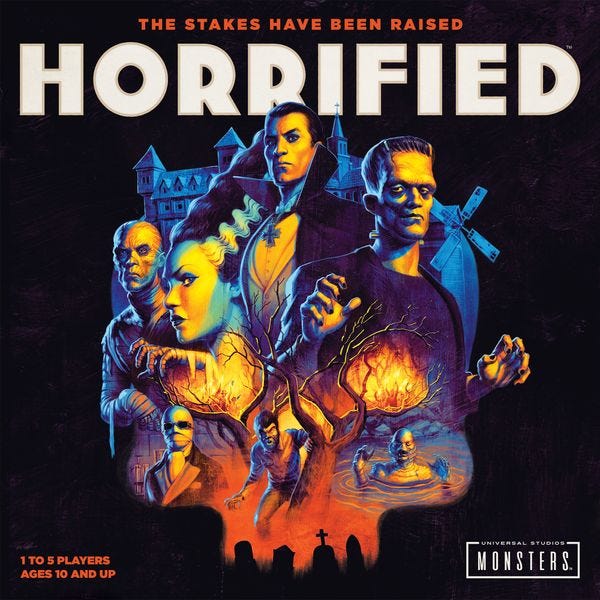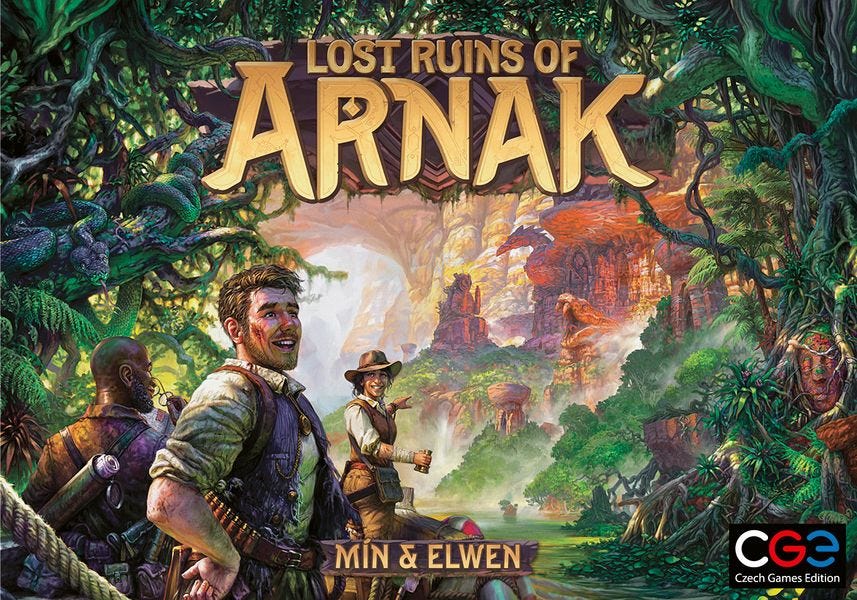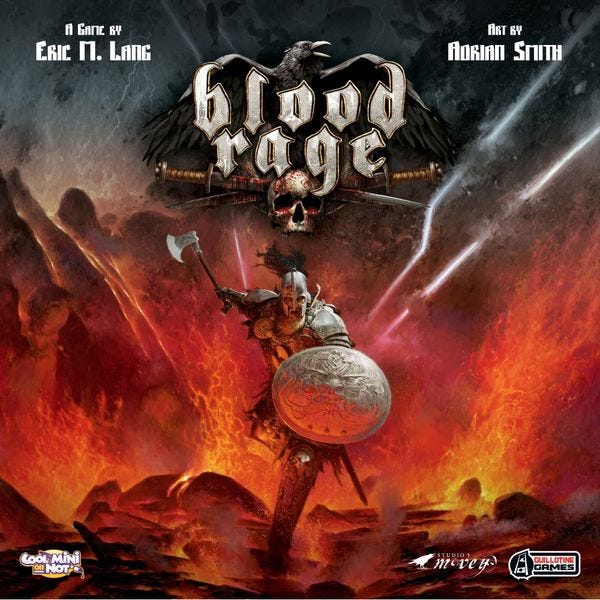I’m really excited to dig into my favorite games of all time as of the end of 2023. This will probably see a seismic shift when I get on the Dice Tower Cruise this week. Can’t wait!
So, for this moment in time, here’s my top 50-41 board games of all time!
50. Ascension Tactics
Players: 1-4 (best 2)
Time: 45-90 mins
BGG Weight: 2.5
The game is only as low as it is for one reason, I’ve only played it solo. I am apprehensive about playing it with other people, because I fear there’s a built in experience gap with Ascension that will punish my opponents in a game neither of us has much experience with. Couple that with the fact that I think I will like it very much, I fear it is a game that has a mental hurdle I need to clear.
Ascension Tactics takes the deckbuilding of the base game and combines it with a skirmish game. It is the closest thing to Yu-gi-oh: Duelist of the Roses I’ve found in board game form. That is one of my favorite video games of all time and this really hits on a lot of the same notes. Players will use the cards to summon heroes to the board. From there, they will vie for positions of power and to beat down their opponent in combat.
The game gives a strategic layer to the tactical nature of both skirmish games and Ascension itself. A co-op campaign in this vein with leaders leveling up similar to Duelist of the Roses might be my favorite game of all time. Maybe I should get to work on that, huh?
49. Meadow
Players: 1-4 (best 2)
Time: 1 hr-90 mins
BGG Weight: 2.24
I like Quadropolis better. So, intrepid readers might question its placement lower on this list. Board gaming is a social activity for me and the people I play games with like Meadow better. It is more inviting, if a little clunkier, and the theme is very appealing.
Meadow sees the players drafting cards in a similar fashion to Quadropolis, but here you can build a hand. Cards play out into a tableau simulating your walk through a meadow and the things you saw on the way. Landscape cards give you the foundations for cards that have a variety of wildlife and there are little side journeys that lead to trinkets you picked up as a memento.
There are randomized pairings that you can claim for other icons, as the claiming tiles in this game are multiuse. I find the game overstays its welcome a little for me, but I can’t deny how much others like it and that means I’m going to pull it off my shelf. There’s no better game than the one someone will play with me, barring a few exceptions.
48. The Gallerist
Players: 1-4 (best 3-4)
Time: 1 hr-150 mins
BGG Weight: 4.25
Vital Lacerda is, for my money, the most consistent heavy game designer on the market. Every one of his games I’ve played has connected to some degree. I suspect that once I play them all, most will have a home on this list. The Gallerist is very challenging, but the theme is integrated so well that the actions make sense almost immediately. That said, knowing what you can do and what you should do are gulfs apart.
You play an art gallery owner, trying to make the most successful gallery. No action space is closed off in this game, as you can bump players from their position at a bonus for bumped player. You can even bump yourself. The actions help you promote certain artists, getting a bonus for being an early supporter. Buy or sell art. Promote your gallery to the masses. All in the pursuit of various goals that show you to be the hippest owner in the world of art.
As someone who has existed in a number of artist communities, it feels very real. The consumerist approach to art might clash with my own desires, but I can’t deny how well they are simulated here. I believe, with experience, I may be able to hang with better players but for now I am content to grow my gallery and revel in this masterclass of game design.
47. Horrified
Players: 1-5 (best 3)
Time: 1 hr
BGG Weight: 2.04
Imagine you wake up tomorrow and you’re in one of the small villages under siege in Universal’s classic monster movies. You’ve got one job, stop the onslaught of two or more of these dark terrors before they slaughter too many villagers. Dracula, The Mummy, The Bride and The Monster, The Creature, The Invisible Man, and the Wolf-man are all potential foes with different ways to beat them back.
You’ll have to be mindful as the other villagers will show up during the fight and need to be escorted to their destination. You’ll pick up red, blue or yellow weapons at the various landmarks from the film catalog and use them to break coffins or solve puzzles. Once you’ve created an opening, it’s time to defeat the villains once and for all.
Horrified is an homage to an era of horror filmmaking we’ll likely never see again. It plays with the Pandemic formula of pick up and delivery in a way that makes more sense. The breadth of choices for player avatars give a little bit of asymmetry, but not so much to be confusing to new players. The endings are usually tense and when they get easy you can bump up the difficulty by adding another threat. It has moved down the rankings in part because there are other co-ops I like better, but also in part because it has seen so much play.
46. Wingspan
Players: 1-4 (best 3)
Time: 40-70 mins
BGG Weight: 2.46
Wingspan is probably the biggest mainstream hit in board gaming since Ticket to Ride (Cards Against Humanity notwithstanding). Stonemaier Games was already a big name in the industry, but this catapulted them to the top of pile for American independent publishers. Elizabeth Hargrave became a premiere designer in a field dominated by men.
It ushered in a bevy of nature themed board games, something that was often seen as a niche in a niche world. The game is as closed to solved as a random game can be. It has one of the most vocal group of haters, which is about as big an endorsement of success you can get in the hobbyist world.
It’s also really fun. Workers are placed on the furthest open space to the right and moved to the left. You activate every thing you can on the way to the end of that line. Birds are added at increasing costs to one of three habitats that provide different actions - laying eggs, providing food or drawing more cards. Everything gives you points, with laying eggs being the most proven strategy.
Cards will have different triggers or scoring objectives and end of round scoring gives you something to work for each round. The game is over after four rounds and your workers reduce each round making the decisions more important as your options open up. It ends before tedium kicks in. The presentation is top tier and a 3rd party app called Wingsong lets you scan the cards to hear each of the birds’ unique call.
45. Sub Terra
Players: 1-6 (best 4)
Time: 1 hr
BGG Weight: 2.15
It took me three tries for Sub Terra to stick. In fact, it took a friend asking me to play it after me having written it off almost completely. Much like Burgle Brothers, I wanted to like it, but for some reason it didn’t click until the right playthrough.
BGG recommends four players and I would say four or more is a good spot to land. This is a game that plays better with a bigger group and even better if the players get into the emergent narrative. You are spelunking in a cave that houses untold terrors. As you search frantically for an exit, you’ll face natural disasters and monsters that seek to claim your lives.
Tiles are flipped over as player explore or try to rescue one another from whatever disaster they face. The roles are fun and thematic and your adrenaline really starts to spike near the end, as players are clinging to life. Some likely separated too much. If your flashlight runs out, you still have a chance to escape and the dice rolls dictate your fate. It can be hard to find and the sequel had a number of production issues, but if you get the chance and like thematic co-ops, this is a great one.
44. Lost Ruins of Arnak
Players: 1-4 (best 3)
Time: 30 min - 2hrs
BGG Weight: 2.91
Sometimes it takes another game for me to appreciate what I have. I was very excited to get Endless Winter when it came out and even more so to play it. My first play was fun and left me wanting more. And then I got more and I started to want more from the game. It was fine, but well…
Then I played Lost Ruins of Arnak again. A game I had played and found wanting itself previously. Now, though, all the things it did appealed to me more. The game still isn’t as good a deckbuilder as I wish, but the worker placement is great. And, while the research track isn’t very exciting compared to the exploration side, I can respect its important thematically. Research is also not really fun for me, but it is necessary.
Going to excavation sites and finding the guardians, on the other hand, is exciting and engaging. The card play can lead to some gratifying combinations and the shifting market is a really cool idea. I do think the game excels at higher player counts, as two player still doesn’t work for me. There is another game that does this combination much better for me and we’ll get into that later this week. Maybe closer to the end?
43. Blood Rage
Players: 2-4 (best 4)
Time: 1 hr-90 mins
BGG Weight: 2.88
Eric M. Lang is arguably the biggest name in American board game development. He has found success in strategy games, family weight games and dice chuckers. He has games that are in Target and games that are amongst the rarest of holy grails (Chaos in the Old World). He’s done great licensed games, even when that was an oxymoron. And Blood Rage is a top 50 game almost a decade after release.
As is the case with most successful games, people have broken and solved this game a hundred times over. The Loki strategy is reviled or revered, depending on the person. Lang gave a great measure of credibility to Cool Mini or Not, a company that has found massive success through Kickstarter. They also face near constant backlash from that success.
Blood Rage is a drafting game that plays out in an area control game. A new take on a classic formula, it was one of the first games to show there was a different way to have dudes on a map. Suddenly, losing ground was a viable strategy if it got you glory in Valhalla. The minis were cool, awesome monsters and Vikings that make the board pop. The card play is fun, building out combos and devising a strategy based on the cards you were passed and the cards you’d have to pass on.
I first played it at Dragon Con and have been a fan ever since. It has slowly fallen down the rankings, but it has a comfortable home here. This is a game I will always be up to play, each time it reminds me why I fell in love in the first place.
42. Seasons
Players: 2-4 (best 2)
Time: 1 hr
BGG Weight: 2.78
You may recall that Millennium Blades really nails the feeling of being a CCG collector. The mania around new packs and the harsh realities of the market place, culminating in tournament play. Seasons is a CCG in a box, with dice drafting to boot.
Players draft cards and then divide them into three piles. One for each era of the game. The dice are rolled and drafted, pushing forward time depending on the dice taken. Different seasons bring different economies and you’ll need to time it just right to play the cards from your hand for maximum effectiveness. Each phase of the game brings a new layer of strategy that falls apart when the dice are thrown.
Players will be able to add more cards to their hand, but it is important to maximize your turn economy. The game ends faster than you expect and once the dice drafting gets underway it can be easy to feel left behind. I’m not very good at Seasons, especially for a game I’ve owned this long (12 years!), but when it hits the table it reminds me of why I fell in love with games like Magic or Vampire in the first place.
41. Last Bastion
Players: 1-4 (best 4)
Time: 45 mins
BGG Weight: 2.61
Last Bastion is a medieval reskinning of Ghost Stories from Antoine Bauza, better known as the creator of 7 Wonders and Takenoko. It is a challenging co-op tower defense game that plays better than most tower defense video games.
Players will randomize the 9 tiles and then be tasked with moving to a tile and taking an action. Every turn, monsters will spawn to lay siege to your castle. You’ll have to fend them off while waiting for their boss. The game play itself is easy, but how you manage the constant threats requires top level communication and team work.
Every game I find myself debriefing and gearing up for the next run. This isn’t a great game to play if you don’t like talking through what you did wrong and what you need to do better. It rewards iteration and experimentation. Learning what your boundaries are, how close to failure you can get on every turn without actually failing. Once you start to learn your limits, the difficulty ramps up and the game really opens up.
Learning how to play all the different characters effectively is its own puzzle and learning how to make them work together is another. In this game more than almost any other, every turn feels like a collaboration. It definitely works best at four players though, while I have played it at two and three and it was excellent, four is ideal.
It isn’t my favorite co-op, but it is still one of my most played recently.
In case you missed it:













